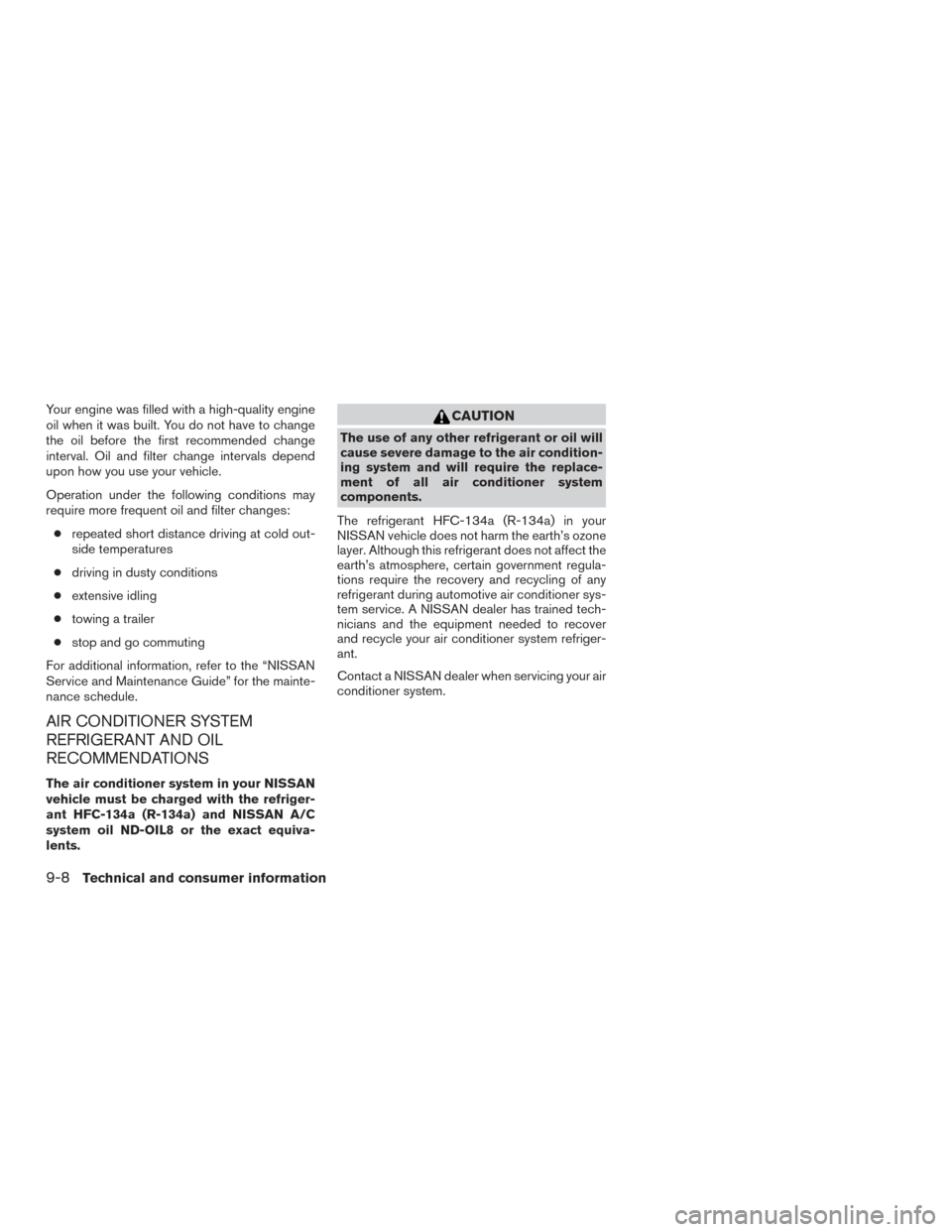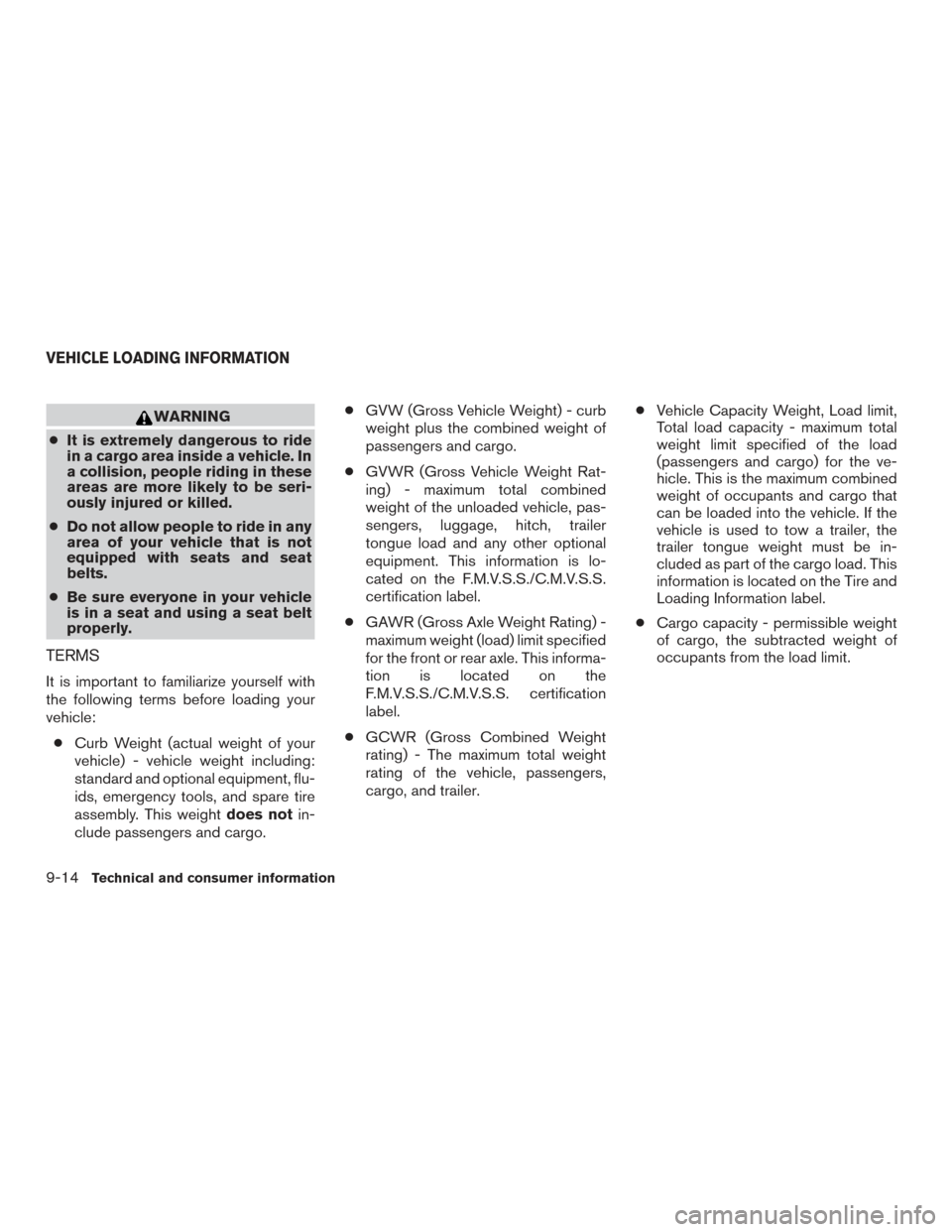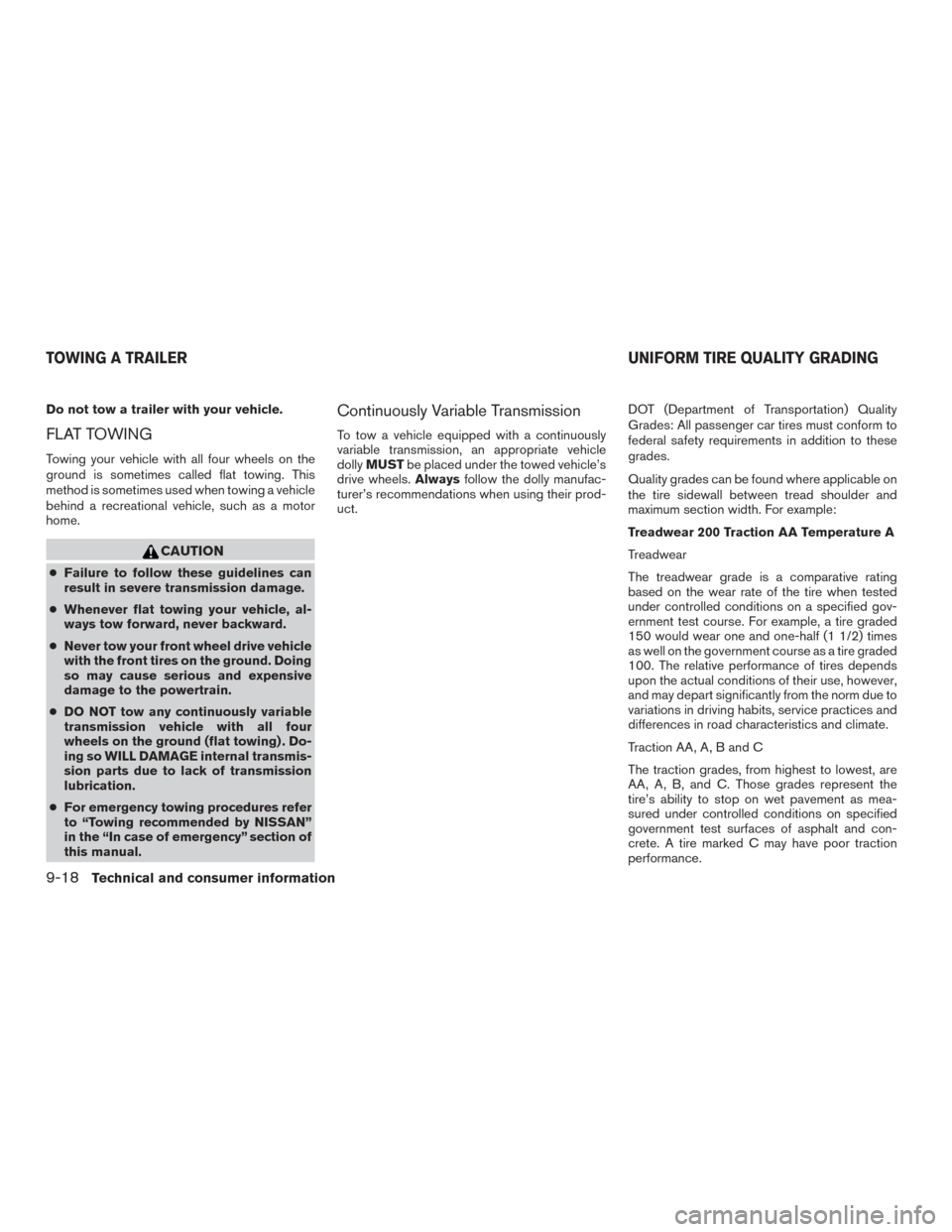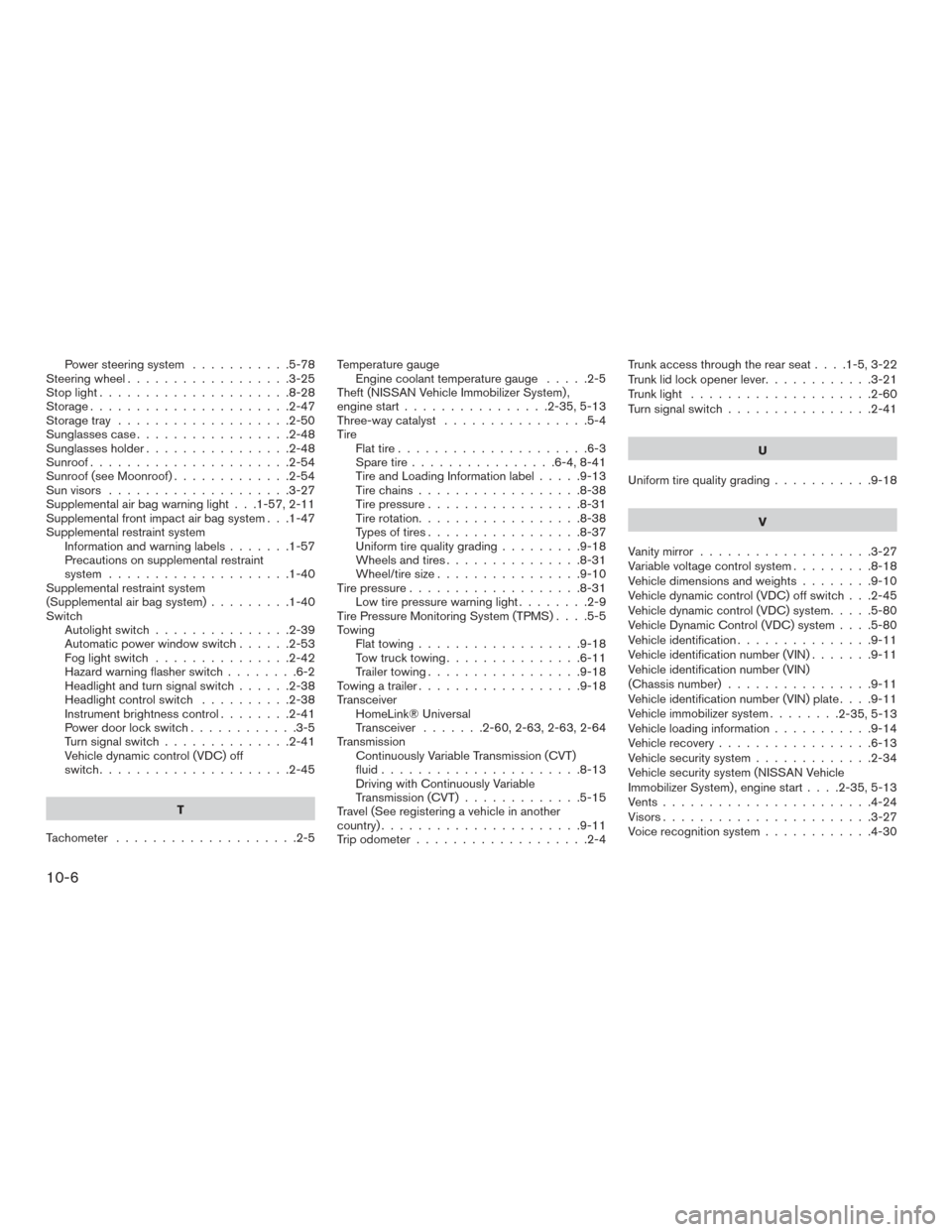2016 NISSAN MAXIMA trailer
[x] Cancel search: trailerPage 363 of 401

Your engine was filled with a high-quality engine
oil when it was built. You do not have to change
the oil before the first recommended change
interval. Oil and filter change intervals depend
upon how you use your vehicle.
Operation under the following conditions may
require more frequent oil and filter changes:● repeated short distance driving at cold out-
side temperatures
● driving in dusty conditions
● extensive idling
● towing a trailer
● stop and go commuting
For additional information, refer to the “NISSAN
Service and Maintenance Guide” for the mainte-
nance schedule.
AIR CONDITIONER SYSTEM
REFRIGERANT AND OIL
RECOMMENDATIONS
The air conditioner system in your NISSAN
vehicle must be charged with the refriger-
ant HFC-134a (R-134a) and NISSAN A/C
system oil ND-OIL8 or the exact equiva-
lents.
CAUTION
The use of any other refrigerant or oil will
cause severe damage to the air condition-
ing system and will require the replace-
ment of all air conditioner system
components.
The refrigerant HFC-134a (R-134a) in your
NISSAN vehicle does not harm the earth’s ozone
layer. Although this refrigerant does not affect the
earth’s atmosphere, certain government regula-
tions require the recovery and recycling of any
refrigerant during automotive air conditioner sys-
tem service. A NISSAN dealer has trained tech-
nicians and the equipment needed to recover
and recycle your air conditioner system refriger-
ant.
Contact a NISSAN dealer when servicing your air
conditioner system.
9-8Technical and consumer information
Page 369 of 401

WARNING
● It is extremely dangerous to ride
in a cargo area inside a vehicle. In
a collision, people riding in these
areas are more likely to be seri-
ously injured or killed.
● Do not allow people to ride in any
area of your vehicle that is not
equipped with seats and seat
belts.
● Be sure everyone in your vehicle
is in a seat and using a seat belt
properly.
TERMS
It is important to familiarize yourself with
the following terms before loading your
vehicle:
● Curb Weight (actual weight of your
vehicle) - vehicle weight including:
standard and optional equipment, flu-
ids, emergency tools, and spare tire
assembly. This weight does notin-
clude passengers and cargo. ●
GVW (Gross Vehicle Weight) - curb
weight plus the combined weight of
passengers and cargo.
● GVWR (Gross Vehicle Weight Rat-
ing) - maximum total combined
weight of the unloaded vehicle, pas-
sengers, luggage, hitch, trailer
tongue load and any other optional
equipment. This information is lo-
cated on the F.M.V.S.S./C.M.V.S.S.
certification label.
● GAWR (Gross Axle Weight Rating) -
maximum weight (load) limit specified
for the front or rear axle. This informa-
tion is located on the
F.M.V.S.S./C.M.V.S.S. certification
label.
● GCWR (Gross Combined Weight
rating) - The maximum total weight
rating of the vehicle, passengers,
cargo, and trailer. ●
Vehicle Capacity Weight, Load limit,
Total load capacity - maximum total
weight limit specified of the load
(passengers and cargo) for the ve-
hicle. This is the maximum combined
weight of occupants and cargo that
can be loaded into the vehicle. If the
vehicle is used to tow a trailer, the
trailer tongue weight must be in-
cluded as part of the cargo load. This
information is located on the Tire and
Loading Information label.
● Cargo capacity - permissible weight
of cargo, the subtracted weight of
occupants from the load limit.
VEHICLE LOADING INFORMATION
9-14Technical and consumer information
Page 373 of 401

Do not tow a trailer with your vehicle.
FLAT TOWING
Towing your vehicle with all four wheels on the
ground is sometimes called flat towing. This
method is sometimes used when towing a vehicle
behind a recreational vehicle, such as a motor
home.
CAUTION
●Failure to follow these guidelines can
result in severe transmission damage.
● Whenever flat towing your vehicle, al-
ways tow forward, never backward.
● Never tow your front wheel drive vehicle
with the front tires on the ground. Doing
so may cause serious and expensive
damage to the powertrain.
● DO NOT tow any continuously variable
transmission vehicle with all four
wheels on the ground (flat towing) . Do-
ing so WILL DAMAGE internal transmis-
sion parts due to lack of transmission
lubrication.
● For emergency towing procedures refer
to “Towing recommended by NISSAN”
in the “In case of emergency” section of
this manual.
Continuously Variable Transmission
To tow a vehicle equipped with a continuously
variable transmission, an appropriate vehicle
dolly MUST be placed under the towed vehicle’s
drive wheels. Alwaysfollow the dolly manufac-
turer’s recommendations when using their prod-
uct. DOT (Department of Transportation) Quality
Grades: All passenger car tires must conform to
federal safety requirements in addition to these
grades.
Quality grades can be found where applicable on
the tire sidewall between tread shoulder and
maximum section width. For example:
Treadwear 200 Traction AA Temperature A
Treadwear
The treadwear grade is a comparative rating
based on the wear rate of the tire when tested
under controlled conditions on a specified gov-
ernment test course. For example, a tire graded
150 would wear one and one-half (1 1/2) times
as well on the government course as a tire graded
100. The relative performance of tires depends
upon the actual conditions of their use, however,
and may depart significantly from the norm due to
variations in driving habits, service practices and
differences in road characteristics and climate.
Traction AA, A, B and C
The traction grades, from highest to lowest, are
AA, A, B, and C. Those grades represent the
tire’s ability to stop on wet pavement as mea-
sured under controlled conditions on specified
government test surfaces of asphalt and con-
crete. A tire marked C may have poor traction
performance.
TOWING A TRAILER
UNIFORM TIRE QUALITY GRADING
9-18Technical and consumer information
Page 383 of 401

Power steering system...........5-78
Steering wheel ..................3-25
Stoplight.....................8-28
Storage......................2-47
Storage tray ...................2-50
Sunglassescase.................2-48
Sunglassesholder................2-48
Sunroof......................2-54
Sunroof (see Moonroof) .............2-54
Sun visors ....................3-27
Supplemental air bag warning light . . .1-57, 2-11
Supplemental front impact air bag system . . .1-47
Supplemental restraint system Information and warning labels .......1-57
Precautions on supplemental restraint
system ....................1-40
Supplemental restraint system
(Supplemental air bag system) .........1-40
Switch Autolightswitch...............2-39
Automatic power window switch ......2-53
Foglightswitch ...............2-42
Hazard warning flasher switch ........6-2
Headlight and turn signal switch ......2-38
Headlight control switch ..........2-38
Instrument brightness control ........2-41
Power door lock switch ............3-5
Turnsignalswitch..............2-41
Vehicle dynamic control (VDC) off
switch.....................2-45
T
Tachometer ....................2-5 Temperature gauge
Engine coolant temperature gauge .....2-5
Theft (NISSAN Vehicle Immobilizer System) ,
engine start ................2-35,5-13
Three-way catalyst ................5-4
Tire Flat tire .....................6-3
Spare tire ................6-4,8-41
Tire and Loading Information label .....9-13
Tirechains..................8-38
Tire pressure .................8-31
Tirerotation..................8-38
Types of tires .................8-37
Uniform tire quality grading .........9-18
Wheels and tires ...............8-31
Wheel/tire size ................9-10
Tire pressure ...................8-31
Low tire pressure warning light ........2-9
Tire Pressure Monitoring System (TPMS) ....5-5
Towing Flattowing..................9-18
Towtrucktowing...............6-11
Trailer towing .................9-18
Towingatrailer..................9-18
Transceiver HomeLink® Universal
Transceiver .......2-60,2-63,2-63,2-64
Transmission Continuously Variable Transmission (CVT)
fluid......................8-13
Driving with Continuously Variable
Transmission (CVT) .............5-15
Travel (See registering a vehicle in another
country) ......................9-11
Trip odometer ...................2-4 Trunkaccessthroughtherearseat....1-5,3-22
Trunklidlockopenerlever............3-21
Trunklight ....................2-60
Turn signal switch
................2-41
U
Uniform tire quality grading ...........9-18
V
Vanity mirror ...................3-27
Variable voltage control system .........8-18
Vehicle dimensions and weights ........9-10
Vehicle dynamic control (VDC) off switch . . .2-45
Vehicle dynamic control (VDC) system .....5-80
Vehicle Dynamic Control (VDC) system ....5-80
Vehicle identification ...............9-11
Vehicle identification number (VIN) .......9-11
Vehicle identification number (VIN)
(Chassis number) ................9-11
Vehicle identification number (VIN) plate ....9-11
Vehicle immobilizer system ........
2-35,5-13
Vehicle loading information ...........9-14
Vehicle recovery .................6-13
Vehicle security system .............2-34
Vehicle security system (NISSAN Vehicle
Immobilizer System) , engine start ....2-35,5-13
Vents.......................4-24
Visors.......................3-27
Voice recognition system ............4-30
10-6